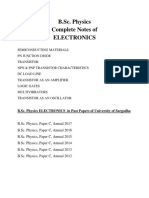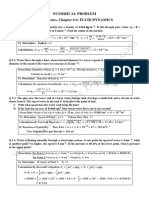Resonance Frequency of A Rejector Circuit
Resonance Frequency of A Rejector Circuit
Uploaded by
ALi HaiderCopyright:
Available Formats
Resonance Frequency of A Rejector Circuit
Resonance Frequency of A Rejector Circuit
Uploaded by
ALi HaiderOriginal Title
Copyright
Available Formats
Share this document
Did you find this document useful?
Is this content inappropriate?
Copyright:
Available Formats
Resonance Frequency of A Rejector Circuit
Resonance Frequency of A Rejector Circuit
Uploaded by
ALi HaiderCopyright:
Available Formats
Resonance frequency of a rejector circuit
Apparatus:
Breadboard
Function generator
Oscilloscope
Digital multimeter (DMM)
Resistance box.
Capacitance box.
Inductance box.
Coaxial cable.
Connecting wires.
Signal generator
AC miliammeter
Theory:
A RLC circuit in which resistor, inductor and capacitor are connected in parallel to each
other. This parallel combination is supplied by voltage supply, VS. This parallel RLC circuit is
exactly opposite to series RLC circuit. in parallel circuit, the voltage across each element remains
the same and the current gets divided in each component depending upon the impedance of each
component. That is why parallel RLC circuit is said to have dual relationship with series RLC
circuit.
When inductive reactance becomes equal to the capacitive reactance at certain
frequency called resonant frequency, the total impedance of the circuit Z becomes equal to R
(Z=R).
Resonance occurs when XL = XC. then:
Parallel LCR resonant circuit is also known as rejector circuit because at resonance the
impedance of the circuit is at its maximum thereby suppressing or rejecting the current whose
frequency is equal to its resonance frequency. At resonance, impedance tends to infinity and
current tends to zero
Thus at resonance, the impedance of the parallel circuit is at its maximum value and equal
to the resistance of the circuit creating a circuit condition of high resistance and low current.
Also at resonance, as the impedance of the circuit is now that of resistance only, the total circuit
current, I will be “in-phase” with the supply voltage, VS.
You might also like
- Lab Reports On Electrical MeasurementDocument9 pagesLab Reports On Electrical Measurementmehrin123100% (1)
- Full Wave RectificationDocument4 pagesFull Wave RectificationMohammad alhaboob2030100% (1)
- 2nd Year Physics Complete NotesDocument133 pages2nd Year Physics Complete Notes12343567890100% (1)
- Electronics BSc..Document45 pagesElectronics BSc..Fida Ur RehmanNo ratings yet
- Experiment 1 KCL KVLDocument9 pagesExperiment 1 KCL KVLRushil ShahNo ratings yet
- Experiment#03 (Rejector Circuit)Document2 pagesExperiment#03 (Rejector Circuit)MUHAMMAD SALEH80% (10)
- American International University-Bangladesh (Aiub) : Meld's ExperimentDocument9 pagesAmerican International University-Bangladesh (Aiub) : Meld's ExperimentShoaib KhanNo ratings yet
- Series and Parallel ResonanceDocument15 pagesSeries and Parallel ResonanceEuric CalityNo ratings yet
- Series Resonance in A Series RLC Resonant CircuitDocument22 pagesSeries Resonance in A Series RLC Resonant CircuitvenkatNo ratings yet
- RLC CircuitDocument7 pagesRLC CircuitPriya Jakoon100% (1)
- RLC Series and ParallelDocument8 pagesRLC Series and ParallelFaizanAshrafNo ratings yet
- Experiment 02 Acceptor Circuit PDFDocument2 pagesExperiment 02 Acceptor Circuit PDFahtisham shah0% (1)
- Lab#3A: Full-Wave Bridge Rectifier Circuit Without and With FilterDocument6 pagesLab#3A: Full-Wave Bridge Rectifier Circuit Without and With FilterSadil BatafNo ratings yet
- Short Questions: (CHAPTER 13) Current ElectricityDocument14 pagesShort Questions: (CHAPTER 13) Current ElectricityEhtesham Ali KhanNo ratings yet
- Numericals - Magnetic CircuitsDocument10 pagesNumericals - Magnetic CircuitsdtrhNo ratings yet
- Alternating Current Class 12 Physics MCQs N QNDocument84 pagesAlternating Current Class 12 Physics MCQs N QNSrishti PathakNo ratings yet
- Experiment No.5-Determination of XD and XQ of Synchronous Machine by Slip TestDocument3 pagesExperiment No.5-Determination of XD and XQ of Synchronous Machine by Slip Test61EEPrabhat PalNo ratings yet
- 12 Class Short QuestionsDocument26 pages12 Class Short QuestionsR.S.H93% (15)
- Lab 04Document10 pagesLab 0449 - 103 - Umair HossainNo ratings yet
- Chapter 15 NotesDocument20 pagesChapter 15 NotesMian EjazNo ratings yet
- 2nd Year Physics Chapter 13 MCQDocument3 pages2nd Year Physics Chapter 13 MCQaamir7malik100% (1)
- Expt 8 BJT Single Stage AmplifierDocument5 pagesExpt 8 BJT Single Stage Amplifiersamarth0% (1)
- Experimental Verification of Network Theorems, UGC Practical - Physics - S - PaulDocument8 pagesExperimental Verification of Network Theorems, UGC Practical - Physics - S - PaulspNo ratings yet
- Boltzmann Constant ExperimentDocument3 pagesBoltzmann Constant Experimentsatyachaudhuri47No ratings yet
- Arthur Bieser Solution Chap 2Document21 pagesArthur Bieser Solution Chap 2Sma Shamsi45% (20)
- Lab RPRT Chauchy ConstantDocument12 pagesLab RPRT Chauchy ConstantMuhammad Shakeel100% (2)
- 2nd Year Physics Chapter 12 MCQDocument3 pages2nd Year Physics Chapter 12 MCQaamir7malikNo ratings yet
- Infinite Series PDFDocument24 pagesInfinite Series PDFNaman SharmaNo ratings yet
- Chapter 3Document46 pagesChapter 3Moin KhanNo ratings yet
- Experiment 05Document6 pagesExperiment 05sandeepverma372No ratings yet
- BEE UNIT 1 Funda of DC Circuits and Magnetic Circuits NotesDocument41 pagesBEE UNIT 1 Funda of DC Circuits and Magnetic Circuits Notespak036No ratings yet
- 2nd Year Physics Chapter 14 MCQDocument3 pages2nd Year Physics Chapter 14 MCQaamir7malikNo ratings yet
- RLC Physics PracticalDocument10 pagesRLC Physics PracticalVacker Guzel83% (6)
- Week 12 - Chapter 17 - RLC CircuitDocument27 pagesWeek 12 - Chapter 17 - RLC CircuitPHẠM ĐỖ ĐỨC KHẢINo ratings yet
- Exp2 - Calibration of Ammeter & VoltmeterDocument4 pagesExp2 - Calibration of Ammeter & VoltmeterKEREN EVANGELINE I (RA1913011011002)50% (2)
- Numerical Problem F.Sc. Physics, Chapter # 6: FLUID DYNAMICSDocument4 pagesNumerical Problem F.Sc. Physics, Chapter # 6: FLUID DYNAMICSfarasat ahmad50% (2)
- Thevenin's TheoremDocument10 pagesThevenin's TheoremKevin RodriguezNo ratings yet
- Circuit Theory Question BankDocument33 pagesCircuit Theory Question Bankaishuvc1822No ratings yet
- Properties of Bulk Matter Class XIDocument35 pagesProperties of Bulk Matter Class XIKAMAL KANT KUSHWAHANo ratings yet
- Practical No: 6: Aim: To Study and Verify Norton's TheoremDocument7 pagesPractical No: 6: Aim: To Study and Verify Norton's TheoremJay Sathvara100% (1)
- Viva Question With AnswersDocument14 pagesViva Question With AnswersAsim AhmedNo ratings yet
- Floyd ED9 Part1 SolutionsDocument162 pagesFloyd ED9 Part1 SolutionsEngin Yiğit75% (44)
- Study of Bridge Rectifier: ObjectivesDocument3 pagesStudy of Bridge Rectifier: ObjectivesDeepak KumbharNo ratings yet
- 1st Year Physics Notes Chap02Document13 pages1st Year Physics Notes Chap02phoool75% (12)
- Experiment-1 L-C-R CircuitDocument4 pagesExperiment-1 L-C-R Circuitiam894083No ratings yet
- Presentation1 1Document10 pagesPresentation1 1Tanmoy GhoshNo ratings yet
- Unit-2 Vector Calculus NotesDocument28 pagesUnit-2 Vector Calculus NotesRam SinghNo ratings yet
- MCQ Questions For Class 12 Physics Chapter 3 Current Electricity AugustDocument16 pagesMCQ Questions For Class 12 Physics Chapter 3 Current Electricity AugustRitika Singh0% (1)
- Unit 1 DC Circuit Analysis PDF 1 8 MegDocument31 pagesUnit 1 DC Circuit Analysis PDF 1 8 MegJoshua Duffy67% (3)
- Physics Notes Fbise FSC 2 CHAPTER - 12 ELECTROSTATICSDocument9 pagesPhysics Notes Fbise FSC 2 CHAPTER - 12 ELECTROSTATICSflyfalcon75% (8)
- Complete Waves and Oscillations-1Document93 pagesComplete Waves and Oscillations-1Samama Fahim86% (21)
- Common Base Characteristics of NPN TransistorDocument18 pagesCommon Base Characteristics of NPN TransistorHenry Oppong100% (2)
- Important Questions For Class 12 Physics Chapter 2 Electrostatic Potential and Capacitance Class 12 Important Questions - Learn CBSEDocument64 pagesImportant Questions For Class 12 Physics Chapter 2 Electrostatic Potential and Capacitance Class 12 Important Questions - Learn CBSEdharan ramNo ratings yet
- Parameters of Choke CoilDocument4 pagesParameters of Choke CoilAnand Kal100% (1)
- Time-Domain Analysis of First-Order RL and RC CircuitsDocument17 pagesTime-Domain Analysis of First-Order RL and RC CircuitsSsmm50% (2)
- Jones Chopper: Pratik Gupta (Vgec Electrical)Document13 pagesJones Chopper: Pratik Gupta (Vgec Electrical)guptapratik100% (1)
- Power FactorDocument13 pagesPower Factorafnanriaz100% (3)
- EEE 211 - Lecture Note2Document9 pagesEEE 211 - Lecture Note2ujirhonicholasNo ratings yet
- SPLM #6 - Resonance and BandwidthDocument60 pagesSPLM #6 - Resonance and BandwidthSherwin Pagpaguitan100% (1)
- Series Resonance in A Series Resonant CircuitDocument10 pagesSeries Resonance in A Series Resonant CircuitProsenjit ChatterjeeNo ratings yet
- Assignment No 2Document10 pagesAssignment No 2ALi HaiderNo ratings yet
- University of Narowal: Program: BS-Mathematics Course Code: Instructor: Semester: 1st Course Title: Islamic StudiesDocument8 pagesUniversity of Narowal: Program: BS-Mathematics Course Code: Instructor: Semester: 1st Course Title: Islamic StudiesALi HaiderNo ratings yet
- Psychology Notes PDFDocument8 pagesPsychology Notes PDFALi HaiderNo ratings yet
- Department of Physics University of Narowal: Assignment No.2 Assignment Topic: Conservative and Non Conservative ForcesDocument9 pagesDepartment of Physics University of Narowal: Assignment No.2 Assignment Topic: Conservative and Non Conservative ForcesALi HaiderNo ratings yet
- Write Short Answers of The Following Questions.: Rana Science AcademyDocument1 pageWrite Short Answers of The Following Questions.: Rana Science AcademyALi HaiderNo ratings yet
- 1st Year Date Sheet 2nd TimeDocument9 pages1st Year Date Sheet 2nd TimeALi HaiderNo ratings yet

































































